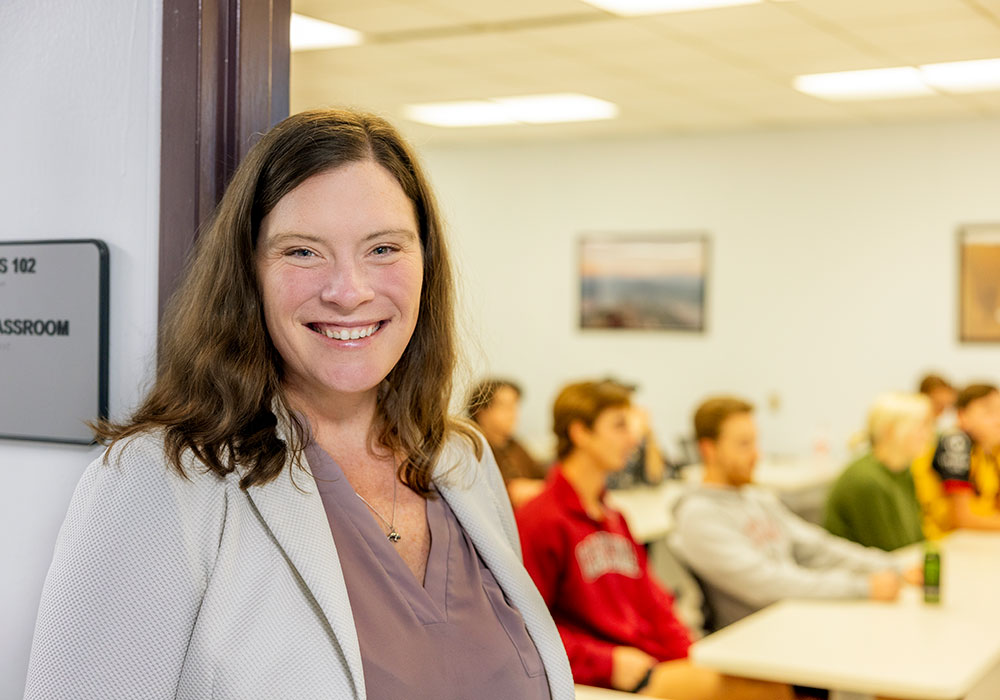Katherine Ryker knows plenty about rocks, plenty about fossils, plenty about the Earth and the forces that have shaped it over time. But the associate professor of geoscience education in the University of South Carolina’s School of the Earth, Ocean and Environment knows just as much about effective teaching.
In addition to a 2023 Michael J. Mungo Undergraduate Teaching Award from USC, Ryker received the American Geophysical Union’s Dorothy LaLonde Stout Education Lecture award this fall for her “significant contributions in Earth and space science education and public outreach.”
But when it comes to her intro-level geology students, Ryker is happiest teaching them how to teach themselves.
“What's important is that you learn the process of observation and interpretation,” she says. “You're really learning how to pay attention to things that may not stand out to you at first. And that’s a skill that I think will serve you in any discipline or career.”
As she explains her teaching philosophy, which is informed by her research in pedagogy but also by her personality, you can’t help but smile. A self-described nerd and class clown, she keeps plush toy fossils in her office: a trilobite and an ammonite. Meanwhile, the geology puns tumble off her tongue like rocks in an avalanche.
She says her work is “grounded in geosciences,” and when you say, “No pun intended?” she fires back: “Oh, every pun intended. Don’t take any pun for granite. Anyone tells you otherwise, it’s a load of schist!”
It’s not all pun-and-games, though. Or if it is, it’s pun-and-games with a purpose. Ryker’s geoscience education research focuses on, among other areas, learning and engagement strategies for large introductory courses in which the majority of students are non-majors.
"You're really learning how to pay attention to things that may not stand out to you at first. And that’s a skill that I think will serve you in any discipline or career."
“The first step, from a cognitive perspective, is triggered situational interest — something has to flip the switch on in your brain to engage you,” she says. “Once we've triggered that interest, it has to be sustained. Then it can be applied further, either in class or out of class.”
One simple strategy involves the learning journal her students use when responding to class reading assignments. Similar journals are employed by educators in a range of disciplines; the value, Ryker says, is in how they’re employed by the student — and the freedom they’re given to pursue their own interests.
“I tell them, ‘This is your documentation that you learned something, and it can be a very simple summary of what you read, that's fine,’ ” she explains. “But it can also be about the wiki hole you went down for two hours because you read that ammonites developed different suture marks over geologic time, and you went, 'What's a suture?’ ”
From there, it’s easier to teach not only information but concepts, processes and observational thinking. As an example, she describes a field trip one of her classes takes to the Saluda River.
“We literally just go sit at the river and look for two hours,” she says. “They draw pictures, they write observations, we talk about those observations, what they mean, and then we try to draw a geological story from all of it. It's a really fun process because they are incentivized to look at things in a way they haven’t before.”
Ideally, those observations lead her students to discover more than just the processes at work in the natural world. And when they do, Ryker is right there on the riverbank, ready to coach them along.
“One student last year came up to me: ‘So how long has that sandbar been there? Like, can you tell?’ I said, ‘Well, let's start from first principles,’ ” she explains. “There's a tree growing in it, so I would hypothesize that the sandbar is at least as old as the tree. We could go take a little core of the tree and count the rings, figure out how old the tree is.”
From there, Ryker and the student ran through a range of evidence-based hypotheses involving trees, rocks, sand and other points of reference in the surrounding environment. Every time the student asked, “What else?” she guided him toward another possible area of inquiry.
Ryker smiles as she finishes the story: “So then he says, ‘You know, my girlfriend works at the canoe rental shop right up the river. I could rent a boat.’ I said, ‘I think you've got yourself an independent study for next semester.’ ”
